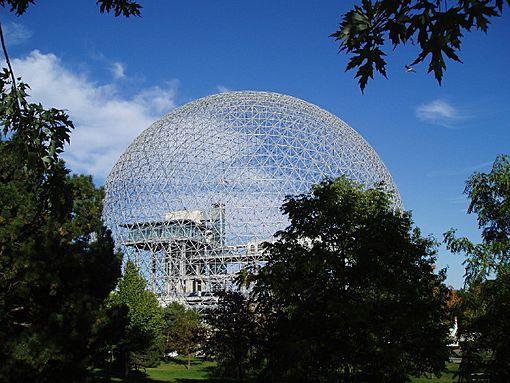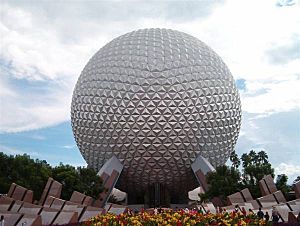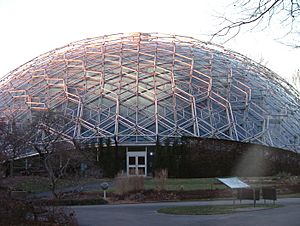Geodesic dome facts for kids

A geodesic dome is a hemispherical thin-shell structure (lattice-shell) based on a geodesic polyhedron. The triangular elements of the dome are structurally rigid and distribute the structural stress throughout the structure, making geodesic domes able to withstand very heavy loads for their size.
History


The first dome that could be called "geodesic" in every respect was designed after World War I by Walther Bauersfeld, chief engineer of the Carl Zeiss optical company, for a planetarium to house his planetarium projector. A first, small dome was patented, constructed by the firm of Dykerhoff and Wydmann on the roof of the Zeiss plant in Jena, Germany. A larger dome, called "The Wonder of Jena", opened to the public in July 1926. Some 20 years later, R. Buckminster Fuller named the dome "geodesic" from field experiments with artist Kenneth Snelson at Black Mountain College in 1948 and 1949. Although Fuller was not the original inventor, he is credited with the U.S. popularization of the idea for which he received U.S. patent 2,682,235 29 June 1954.
The geodesic dome appealed to Fuller because it was extremely strong for its weight, its "omnitriangulated" surface provided an inherently stable structure, and because a sphere encloses the greatest volume for the least surface area.
The dome was successfully adopted for specialized uses, such as the 21 Distant Early Warning Line domes built in Canada in 1956, the 1958 Union Tank Car Company dome near Baton Rouge, Louisiana, designed by Thomas C. Howard of Synergetics, Inc. and specialty buildings such as the Kaiser Aluminum domes (constructed in numerous locations across the US, e.g., Virginia Beach, Virginia), auditoriums, weather observatories, and storage facilities. The dome was soon breaking records for covered surface, enclosed volume, and construction speed.
Beginning in 1954, the U.S. Marines experimented with helicopter-deliverable geodesic domes. A 30-foot wood and plastic geodesic dome was lifted and carried by helicopter at 50 knots without damage, leading to the manufacture of a standard magnesium dome by Magnesium Products of Milwaukee. Tests included assembly practices in which previously untrained Marines were able to assemble a 30-foot magnesium dome in 135 minutes, helicopter lifts off aircraft carriers, and a durability test in which an anchored dome successfully withstood a day-long 120 mph (190 km/h) propeller blast from the twin 3,000 horsepower engines of an anchored airplane without damage.
The dome was introduced to a wider audience as a pavilion for the 1964 World's Fair in New York City designed by Thomas C. Howard of Synergetics, Inc. This dome is now used as an aviary by the Queens Zoo in Flushing Meadows Corona Park after it was redesigned by TC Howard of Synergetics, Inc.
Another dome is from Expo 67 at the Montreal World's Fair, where it was part of the American Pavilion. The structure's covering later burned, but the structure itself still stands and, under the name Biosphère, currently houses an interpretive museum about the Saint Lawrence River.
In the 1970s, Zomeworks licensed plans for structures based on other geometric solids, such as the Johnson solids, Archimedean solids, and Catalan solids. These structures may have some faces that are not triangular, being squares or other polygons.
In 1975, a dome was constructed at the South Pole, where its resistance to snow and wind loads is important.
On October 1, 1982, one of the most famous geodesic domes, Spaceship Earth at the EPCOT Center in Walt Disney World (Bay Lake, Florida), opened. The building and the ride inside of it are named with one of Buckminster Fuller's famous terms, Spaceship Earth, a world view expressing concern over the use of limited resources available on Earth and encouraging everyone on it to act as a harmonious crew working toward the greater good. The building is Epcot's icon, and is also included in the park's logo.
In 2000, the world's first fully sustainable geodesic dome hotel, EcoCamp Patagonia, was built in Chilean Patagonia opening the following year in 2001. The hotel's dome design is key to resisting the region's strong winds and is based on the dwellings of the indigenous Kaweskar people.
Images for kids
-
Science World in Vancouver, built for Expo 86, and inspired by Buckminster Fuller's Geodesic dome
-
RISE, public art designed by Wolfgang Buttress located in Belfast consists of two spheres which also utilise Buckminster Fuller's Geodesic dome
See also
 In Spanish: Cúpula geodésica para niños
In Spanish: Cúpula geodésica para niños





